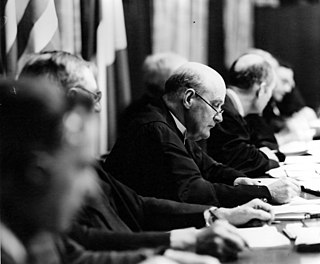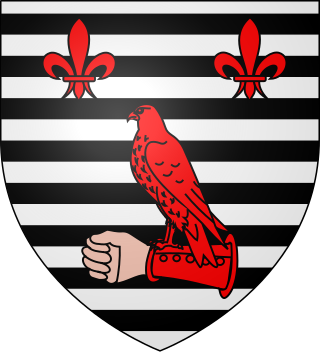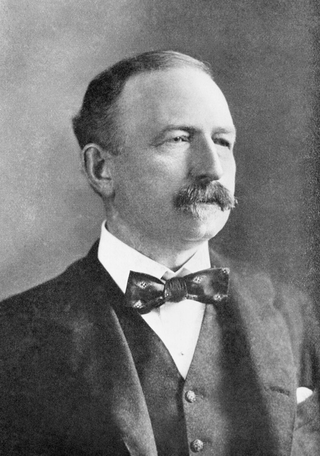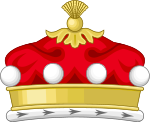
Viscount Chandos, of Aldershot in the County of Southampton, is a title in the Peerage of the United Kingdom and held by a branch of the Lyttelton family. It was created in 1954 for the businessman and public servant Oliver Lyttelton. He was the son of the politician and sportsman Alfred Lyttelton, eighth son of George Lyttelton, 4th Baron Lyttelton, whose eldest son, the 5th Baron Lyttelton, also succeeded his kinsman The 3rd Duke of Buckingham and Chandos as 8th Viscount Cobham in 1889. As of 2017 the title of Viscount Chandos is held by the first Viscount's grandson, the third Viscount, who succeeded his father in 1980. He lost his seat in the House of Lords after the passing of the House of Lords Act of 1999, which removed the automatic right of hereditary peers to sit in the upper chamber of Parliament. However, in 2000 he was given a life peerage as Baron Lyttelton of Aldershot, of Aldershot in the County of Hampshire, and was thus able to return to the House of Lords, where he now sits on the Labour benches. Lord Chandos is also in remainder to the viscountcy of Cobham and its subsidiary titles the barony of Cobham, the barony of Lyttelton, the barony of Westcote and the baronetcy of Frankley.
Viscount Younger of Leckie, of Alloa in the County of Clackmannan, is a title in the Peerage of the United Kingdom. It was created on 20 February 1923 for the Unionist politician Sir George Younger, 1st Baronet. He had already been created a Baronet, of Leckie in the County of Clackmannan, in the Baronetage of the United Kingdom, on 12 July 1911. His grandson, the third Viscount, served as Lord Lieutenant of Stirlingshire from 1964 to 1979, whilst the third Viscount's brother was Labour MP Kenneth Younger. His son, the fourth Viscount, was a prominent Conservative politician. In 1992, five years before he succeeded his father, he was created a life peer as Baron Younger of Prestwick, of Ayr in the District of Kyle and Carrick. As of 2017, the titles are held by his son, the fifth Viscount, who succeeded in 2003 and joined the House of Lords as an elected hereditary peer in 2010.

Baron Ashtown, of Moate in the County of Galway, is a title in the Peerage of Ireland. It was created in 1800 for Frederick Trench, with remainder to the heirs male of his father.

Geoffrey Lawrence, 3rd Baron Trevethin, 1st Baron Oaksey, was the lead British judge during the Nuremberg trials after Second World War, and President of the International Military Tribunal.

Baron Glentoran, of Ballyalloly in the County of Down, is a title in the Peerage of the United Kingdom. It was created on 8 July 1939 for the Unionist politician Herbert Dixon. In 1950 he also succeeded his elder brother as third Baronet, of Ballymenock. His son, the second Baron, was also a politician and served as the last Speaker of the Senate of Northern Ireland. As of 2017 the titles are held by the latter's son, the third Baron, who succeeded in 1995. He is a former Olympic bobsleigh gold medallist as well as a soldier, businessman and politician. Lord Glentoran was one of the ninety elected hereditary peers who remain in the House of Lords after the passing of the House of Lords Act 1999, and sat on the Conservative benches until his June 2018 retirement under the House of Lords Reform Act 2014.
Baron de Mauley, of Canford in the County of Dorset, is a title in the Peerage of the United Kingdom. It was created on 10 July 1838 for the Whig politician the Hon. William Ponsonby, who had earlier represented Poole, Knaresborough and Dorset in the House of Commons. He was the third son of the 3rd Earl of Bessborough, an Anglo-Irish peer, and his wife Lady Henrietta Spencer, daughter of the 1st Earl Spencer. He married Lady Barbara Ashley-Cooper, the daughter of Anthony Ashley-Cooper, 5th Earl of Shaftesbury. She was one of the co-heirs to the ancient barony by writ of Mauley, which superseded the feudal barony the caput of which was at Mulgrave Castle, Yorkshire, which barony by writ had become extinct in 1415.

Baron Astor of Hever, of Hever Castle in the County of Kent, is a title in the Peerage of the United Kingdom. It was created in 1956 for John Jacob Astor, a prominent newspaper proprietor and Conservative politician. He was the fourth child of William Waldorf Astor, 1st Viscount Astor. Lord Astor of Hever was succeeded in 1971 by his eldest son, the second Baron, who served as Lord Lieutenant of Kent between 1972 and 1982.
Baron Skelmersdale, of Skelmersdale in the County Palatine of Lancaster, is a title in the Peerage of the United Kingdom. It was created in 1828 for the former Member of Parliament for Westbury, Newcastle-under-Lyme, Clitheroe and Dover, Edward Bootle-Wilbraham. His grandson, the second Baron, was a Conservative politician and served in the Conservative administrations of Disraeli and Lord Salisbury. In 1880 he was created Earl of Lathom, in the County Palatine of Lancaster, in the Peerage of the United Kingdom. However, the earldom became extinct on the death of his grandson, the third Earl, in 1930. The barony passed to the last Earl's second cousin once removed, the fifth Baron, who was the grandson of a younger son of the first Baron. On his death, the title was inherited by his cousin, the sixth Baron.

Baron Shaughnessy, of the City of Montreal in the Dominion of Canada and of Ashford in the County of Limerick, is a title in the Peerage of the United Kingdom. It was created in 1916 for the Milwaukee born businessman Thomas Shaughnessy, president of the Canadian Pacific Railway Company. He was succeeded by his eldest son, the second Baron, a Director of the CPR and of the Canadian Bank of Commerce. His son, the third Baron, was a businessman and was also active in the House of Lords. However, he lost his hereditary seat in parliament after the House of Lords Act 1999.
Baron Shepherd, of Spalding in the County of Lincoln, is a title in the Peerage of the United Kingdom. It was created in 1946 for George Shepherd, who had previously served as National Agent of the Labour Party. His only son, Malcolm Newton Shepherd, 2nd Baron Shepherd the second Baron, was also a prominent Labour politician and notably served as Leader of the House of Lords. After the House of Lords Act 1999 removed the automatic right of hereditary peers to sit in the House of Lords he was given a life peerage as Baron Shepherd of Spalding, of Spalding in the County of Lincolnshire. This enabled him to remain an active member of the House of Lords On his death in 2001 the life barony became extinct, while he was succeeded in the hereditary barony by his eldest son, Graeme, the third and present holder of the title.
Baron Mancroft, of Mancroft in the City of Norwich, is a title in the Peerage of the United Kingdom. It was created in 1937 for the Conservative politician Sir Arthur Samuel, 1st Baronet. He had already been created a Baronet, of Mancroft in the City of Norwich in the County of Norfolk, in 1932. His son, the second Baron, was also a Conservative politician. In 1925 he assumed by deed poll the surname of Mancroft. As of 2010 the titles are held by the latter's only son, the third Baron, who succeeded in 1987. He is one of the ninety elected hereditary peers that remain in the House of Lords after the passing of the House of Lords Act of 1999. Lord Mancroft sits on the Conservative benches.
Baron Bridges, of Headley in the County of Surrey and of Saint Nicholas at Wade in the County of Kent, is a title in the Peerage of the United Kingdom. It was created on 4 February 1957 for the prominent civil servant Sir Edward Bridges. He was Cabinet Secretary from 1938 to 1946. He was succeeded by his son, the second Baron, in 1969. He notably served as British Ambassador to Italy from 1983 to 1987. Lord Bridges was one of the ninety-two elected hereditary peers that remained in the House of Lords after the passing of the House of Lords Act 1999, before his removal for non-attendance in 2016. As of 2017 the title is held by his son, the third Baron, who succeeded to the title in that year. He was the solicitor to, among others, Queen Elizabeth II and other members of the royal family.
Baron Trefgarne, of Cleddau in the County of Pembroke, is a title in the Peerage of the United Kingdom. It was created in 1947 for the barrister, journalist and politician, George Garro-Jones. In 1954 he assumed by deed poll the surname of Trefgarne in lieu of Garro-Jones. As of 2016 the title is held by his son, the second Baron, who succeeded in 1960. He served in junior ministerial positions in the Conservative administrations of Margaret Thatcher and is now one of the ninety elected hereditary peers that remain in the House of Lords after the passing of the House of Lords Act 1999.
Baron Crathorne, of Crathorne in the North Riding of the County of York, is a title in the Peerage of the United Kingdom. It was created in 1959 for the Conservative politician and former Minister of Agriculture and Fisheries, Sir Thomas Dugdale, 1st Baronet. He had already been created a baronet, of Crathorne in the North Riding of the County of York, in 1945. As of 2016 the titles are held by his son, the second Baron, who succeeded in 1977. Lord Crathorne is one of the ninety elected hereditary peers that remain in the House of Lords after the passing of the House of Lords Act 1999, and sits as a Conservative.

Baron Colgrain, of Everlands in the County of Kent, is a title in the Peerage of the United Kingdom. It was created in 1946 for the Scottish banker Colin Campbell. He was President of the British Bankers' Association from 1938 to 1946. As of 2017 the title is held by his great-grandson, the fourth Baron, who succeeded his father in 2008. Since 2017 he has been one of the 92 hereditary peers chosen to remain in the House of Lords under the House of Lords Act 1999.

Baron Rea, of Eskdale in the County of Cumberland, is a title in the Peerage of the United Kingdom. It was created in 1937 for the businessman and Liberal politician Sir Walter Rea, 1st Baronet, who had earlier represented Scarborough, Bradford North and Dewsbury in the House of Commons. He had already been created a Baronet, of Eskdale in the County of Cumberland, in 1935. He was succeeded by his eldest son, the second Baron. During the Second World War he served as personal staff officer to Brigadier Colin Gubbins, the Head of SOE, a key British intelligence and guerrilla operations agency. Lord Rea served as Leader of the Liberal Party in the House of Lords from 1955 to 1967. His daughter, the Right Hon. Ann Felicity Rea, married SOE veteran Malcolm Munthe in 1945. His nephew, the third Baron, who succeeded in 1981, was a physician. He was one of the ninety elected hereditary peers elected to remain in the House of Lords after the passing of the House of Lords Act 1999, and sat on the Labour benches. As of 2020 the titles are held by his son, the fourth Baron, who succeeded his father in that year.
Baron Rotherwick, of Tylney in the County of Southampton, is a title in the Peerage of the United Kingdom.

Alfred Tristram Lawrence, 1st Baron Trevethin, PC was a British lawyer and judge. He served as Lord Chief Justice of England and Wales from 1921 to 1922. He is best remembered for the questionable manner in which he became Lord Chief Justice, under a plan devised by David Lloyd George.
Charles Trevor Lawrence, 2nd Baron Trevethin, DSO, DL, MA was a British Army officer and peer.

Patrick John Tristram Lawrence, 5th Baron Trevethin and 3rd Baron Oaksey, is a British barrister, hereditary peer and crossbench member of the House of Lords. He was educated at Christ Church, Oxford.













